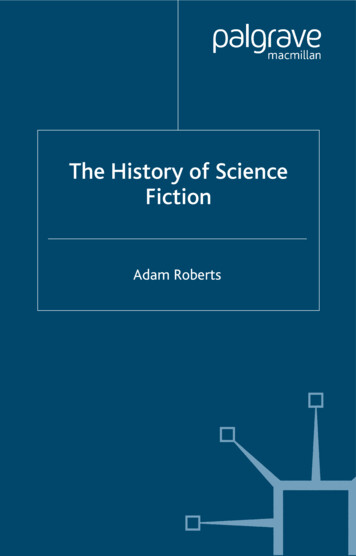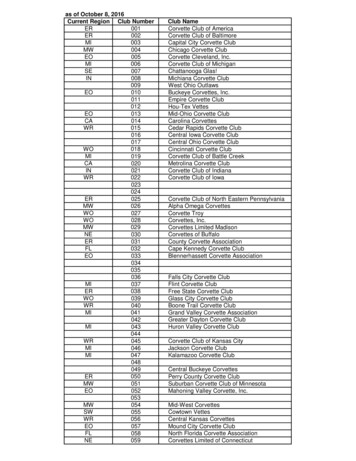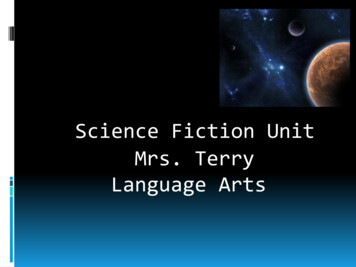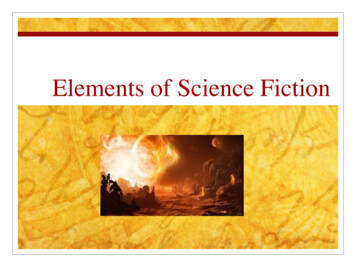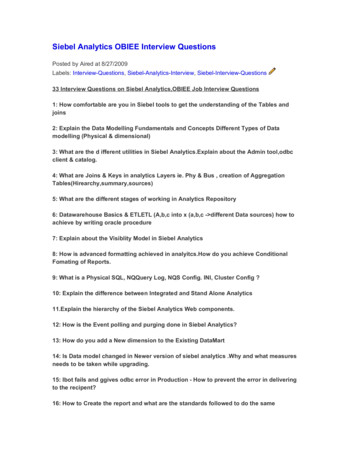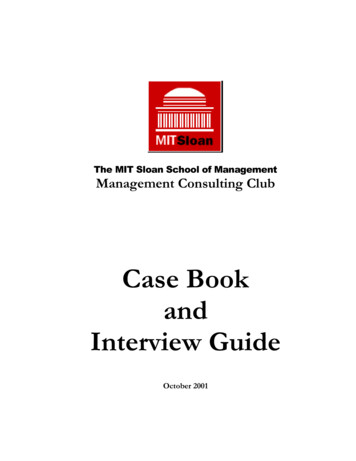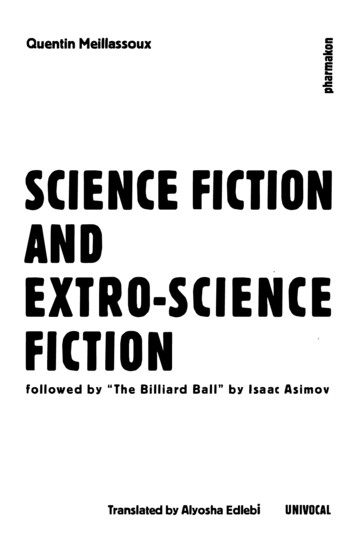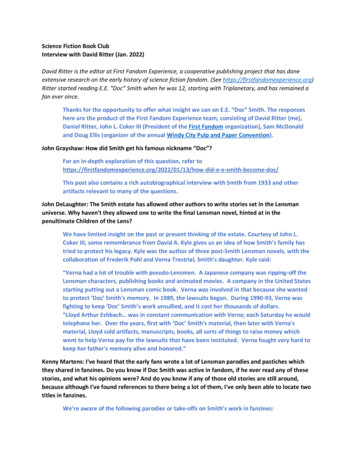
Transcription
Science Fiction Book ClubInterview with David Ritter (Jan. 2022)David Ritter is the editor at First Fandom Experience, a cooperative publishing project that has doneextensive research on the early history of science fiction fandom. (See https://firstfandomexperience.org)Ritter started reading E.E. “Doc” Smith when he was 12, starting with Triplanetary, and has remained afan ever since.Thanks for the opportunity to offer what insight we can on E.E. “Doc” Smith. The responseshere are the product of the First Fandom Experience team, consisting of David Ritter (me),Daniel Ritter, John L. Coker III (President of the First Fandom organization), Sam McDonaldand Doug Ellis (organizer of the annual Windy City Pulp and Paper Convention).John Grayshaw: How did Smith get his famous nickname “Doc”?For an in-depth exploration of this question, refer -did-e-e-smith-become-doc/This post also contains a rich autobiographical interview with Smith from 1933 and otherartifacts relevant to many of the questions.John DeLaughter: The Smith estate has allowed other authors to write stories set in the Lensmanuniverse. Why haven't they allowed one to write the final Lensman novel, hinted at in thepenultimate Children of the Lens?We have limited insight on the past or present thinking of the estate. Courtesy of John L.Coker III, some remembrance from David A. Kyle gives us an idea of how Smith’s family hastried to protect his legacy. Kyle was the author of three post-Smith Lensman novels, with thecollaboration of Frederik Pohl and Verna Trestrial, Smith’s daughter. Kyle said:“Verna had a lot of trouble with pseudo-Lensmen. A Japanese company was ripping-off theLensman characters, publishing books and animated movies. A company in the United Statesstarting putting out a Lensman comic book. Verna was involved in that because she wantedto protect ‘Doc’ Smith's memory. In 1989, the lawsuits began. During 1990-93, Verna wasfighting to keep ‘Doc’ Smith’s work unsullied, and it cost her thousands of dollars.“Lloyd Arthur Eshbach was in constant communication with Verna; each Saturday he wouldtelephone her. Over the years, first with ‘Doc’ Smith's material, then later with Verna'smaterial, Lloyd sold artifacts, manuscripts, books, all sorts of things to raise money whichwent to help Verna pay for the lawsuits that have been instituted. Verna fought very hard tokeep her father's memory alive and honored.”Kenny Martens: I've heard that the early fans wrote a lot of Lensman parodies and pastiches whichthey shared in fanzines. Do you know if Doc Smith was active in fandom, if he ever read any of thesestories, and what his opinions were? And do you know if any of those old stories are still around,because although I've found references to there being a lot of them, I've only been able to locate twotitles in fanzines.We’re aware of the following parodies or take-offs on Smith’s work in fanzines:
“The Skylaugh of Space” by “Omnia”Fantasy Magazine, v3n3, May 1934 and v3n4, June 1934"Omnia" is described in the July 1934 issue of Fantasy Magazine as “a young chap whohas shown promise in the science fiction field, having already sold stories to Wonderand Amazing. Besides, he is editor of his college humor magazine ”Fitting this description is Milton Kaletsky, frequent fanzine contributor and author ofsuch stories as "The End of the Universe" (Wonder Stories, April 1934) and "The Beam"(Amazing Stories, September 1934).“Whither Wollheim” by Richard WilsonFantascience Digest, v1n5, July-August 1938Not strictly a Smith parody but invokes his work heavily.“Skylark Versus Thought” by Milton A. RothmanFantascience Digest, v1n6, September-October 1938“Pielark Patrol” by Tony StrotherD’Journal, v1n2, March 1939“The Skylark of Love” by Philia HygheD’Journal, v1n3, May 1939“Lensman on the Loose” by Al AshleyNova, v1n1, November-December 1941“Doomed Lensman” by Sybly WhiteSerialized in The Third Foundation beginning with n77, 1967Text is online here: .htmAppears to be an attempt at a serious addition to the Lensman sagaWe’ve made the early fanzine pastiches available in a blog post, edward-elmer-smith-ph-d/Others were published later, not in fanzines: Star Smashers of the Galaxy Rangers by Harry HarrisonPutnam, 1973“Backstage Lensman” by Randall GarrettAnalog Science Fiction/Science Fact, June 1978This list excludes the authorized extensions such as David A. Kyle’s The Dragon Lensman.A collection of more recent fanfic can be found tmWe haven’t seen any direct commentary on these works from Smith.Jim Dean: Skylark and Lensman are full of pithy remarks by the characters, such as “you’re a blindingflash and a deafening report” what are some of your favorites - and which ones to your knowledgewere not commonly used in the era he wrote? And did he speak like that himself?
Perhaps the “Smithism” that’s most widely and durably promulgated is “Clear ether!” This isessentially the space-faring equivalent of “Smooth sailing!” or “Safe travels!”The first appearance of this phrase seems to be in Spacehounds of IPC, where it’s used as ageneral dismissal of concern:“You two seem to know Miss Pickering extraordinarily well. Would I be stepping on your toesif I give her a play?”“Clear ether as far as we’re concerned,” Brandon shrugged his shoulders. “She’s been kickingaround under foot since she was knee high to a duck -- we gave her her first lessons on a sliderule.”“Don’t be dumb, Norman. That woman’s a knock-out – a riot – a regular tri-planet call-out!”“Oh, she’s all x, as far as that goes. She’s a good little scout, too – not half as dumb as she acts– and she’s one of the squarest little aces that ever waved a plume ”This dialog reflects Smith’s hallmark, idiomatic, pseudo-futuristic, adventure-sagaphraseology: “a regular tri-planet call-out ”; “she’s all x ” This sort of wordplay oftenappeared when the subject turned to women. It’s oddly both “of the period,” reflecting thecasual objectification of the 1930s – and adapted to the sci-fi context. Even so, it’s possiblethat some of this dialog originated with Smith’s wife Jeanne, or Lee Hawkins Garby, Smith’sco-author on Skylark of Space. Per Smith’s 1933 interview in Science Fiction Digest, the twowomen were responsible for contributing the “love story” aspects of the stories.Other sayings of note: “QX,” meaning “Okay” or “Roger”“Flit,” meaning “leave abruptly or with urgency”“You’re full of little red ants,” meaning “you’re full of baloney”This isn’t original with Smith. We don’t know the etymology.“Thank Klono” and “I wish to Klono,” where Klono is God, or the god of spacers, orsome such that should be thanked or wished upon, and who has an array of metalbody parts (“golden gills,” “gadolinium guts,” and so on) which are alternately cursedand blessed“Wide-open two-way,” a completely open exchange of thought between two people“I check you to (some number of) decimal places,” meaning, “I strongly agree”Regarding “blinding flash and deafening report,” the phrase seems a bit out-of-sync with thesetting. Sound doesn’t propagate in the vacuum of the ether.Robert A. Heinlein said of Smith:“In casual conversation Doc used a number of clichés . . . and his male lead characters used thesame or similar ones. This is a literary fault? I think not. In casual speech most people tend torepeat each his own idiosyncratic pattern of clichés. Doc’s repertory of clichés was quitecolorful, especially so when compared with patterns heard today that draw heavily on “TheSeven Words That Must Never Be Used in Television.”
But in his public presentations, Smith decidedly did not speak in the mode of hisswashbuckling characters. For a rich sample of the author’s style of more formal address, readthe text of his Guest of Honor address to the 1940 World Science Fiction Convention atFanac.org: 01.htmlRobert Matthew Knuckles: What kind of emotions did he have watching rocket development and theSpace Race in general prior to his death in 1965?John Hayes: I'd be more interested in his reaction to solid state electronics, wish he'd lived longenough to see micro-computers. Always find his space tech version of Victorian electrical circuits andswitching gear fun, the original steam punk? Oh, and the electronic valves.Sadly, Smith wrote little about himself in later life, and there’s never been a robust biography.We don’t have any understanding of how his feelings regarding new technology evolved overthe years.Though certain mechanical aspects of Smith’s technology have a steam-punky feel, mostwould attribute the origin of that genre more to Verne and (to a lesser extent) Wells.Chris Sudall: Do you think he would've gone on to write more D'Alembert novels himself? Would hehave approved of the series written? I quite enjoyed them and they were the first books to get meback to Science Fiction (for the covers alone!)It’s very hard to say. All the extensions of his universe and characters appeared after hisdeath. This could be an indication that he held his ideas close to his vest during his life.Ed Newsom: When were these stories appearing in the author's life? Who would he have read/beenreading when he was writing them?Smith was born on May 2, 1890. He began work on what became The Skylark of Space as earlyas 1916, but this first work wasn’t published until 1928. He was older than most writing at thetime. He was already married and established in his professional career. He wrote mostactively in the late 1930s and early 1940s.On the second part of the question, see the answers below on Smith’s influences.Ed Newsom: What was Smith like as a person?We’ve never found anyone who wrote a negative word about Smith as a person, even if theydidn’t care for his writing. The 1939 description by young fan Erle Korshak in our blog post is agreat example of his openness and genuine affection for his readers.From Forrest J Ackerman we have this nugget, courtesy of John L. Coker III:“Edward Elmer “Doc” Smith was a vivacious individual. He liked to race his car. I understandthat one time Heinlein was sitting next to ‘Doc’ as he was driving about ninety miles an hour.Oddly enough, while he was a Ph.D., he made a living in doughnuts.”In a 1979 tribute, Smith’s daughter Verna said:“Daddy was such a knowledgeable, helpful, understanding and brilliant human being with anabsolute passion for seeking to learn all that he could. The last year of his life, at seventy-five,
he enrolled at Northwestern University for a course in ‘Black Holes in Space.’ No problem wastoo minute for him to investigate and do something about if it would help another.”Robert A. Heinlein wrote:“In each story Doc’s male lead character is a very intelligent, highly educated, cheerful,emotional, enthusiastic, and genuinely modest man who talks exactly like Doc Smith who wasa very intelligent, highly educated, cheerful, emotional, enthusiastic, and genuinely modestman.”Eva Sable: I'll admit it. I have never read any of his work. Have them, haven’t cracked a single oneopen. Should I just jump in chronologically as is my wont, or is there another starting point that mayexcite me into continuing?David Ritter: The book that first captured me was Triplanetary. (The full book version from1948, not the shorter serial version from Amazing Stories in 1934.) The epic scope with thesweep of history from the ancient past in the future was compelling to me (at 12 years old).I’ve re-read it several times since. Like all his work, some parts don’t age well, but as an epicyarn it still excites. If you enjoy that book, then the rest of the Lensman series is the naturalfollow-on. Skylark can wait and be read if you still have an appetite, IMHO.Daniel Ritter: I think Galactic Patrol might be my favorite. Kimball Kinnison is quintessentialSmith for me. As I recall this is really where I feel like the memorable space battles pick up,and the overall universe Smith builds to is in full form. The slave race / master race arc ismemorable to me – the Velatians and Delgonian overlords. Galactic Patrol could even be agood place to start reading Smith, but I think a thorough read through should probably beginwith Triplanetary.Ed Newsom: Would you share some Smith-Heinlein anecdotes?It’s likely that Smith and Heinlein first met in person at the September 12 1940 meeting of theLos Angeles Science Fiction Society, subsequently deemed the “Skylark Meeting.” Smith wasthe Guest of Honor, having driven to LA following the 1940 Worldcon in Chicago. We knowthat Heinlein and his wife attended, as did Jack Williamson, Edward Hamilton, Ray Bradbury,Leigh Brackett and Ray Harryhausen.Heinlein reported this incident:“August 1940 – back road near Jackson, Michigan – a 1939 Chevrolet Sedan: ‘Doc’ Smith wasat the wheel; I am in the righthand seat and trying hard to appear cool, calm, fearless – acredit to the Patrol. Doc has the accelerator floorboarded but has his head tilted over atninety degrees so that he can rest his skull against the frame of the open left window in orderto listen by bone conduction for body squeaks.Doc could do almost anything and do it quickly and well. In this case he was selection a roadtesting for me a secondhand car. After rejecting numberless other cars, he approved this one; Ibought it. I drove that car for twelve years. Doc Smith has not missed anything.It's name? Skylark Five, of course.”Heinlein also described this conversation regarding a scene in Spacehounds of IPC:
“[This scene is] almost purely autobiographical in that it tells why the male lead, ‘Steve’Stevens, knows how to fabricate from the wreckage at hand everything necessary to rescueNadia and himself. I once discussed with Doc these two chapters, in detail; he convinced methat his hero character could do these things by convincing me that he, Edward E. Smith, coulddo all of them. . . and, being myself an experienced mechanical engineer, it was not possiblefor him to give me a ‘snow job. (I think he lacked the circuitry to give a ‘snow job’ in any case;incorruptible honesty was Dr. Smith’s prime attribute-with courage to match it.)”David Stuckey: There are a lot of mentions by Smith about his consulting with other technical peopleon certain matters in the Lensman books when his own knowledge was limited; Is it possible to namesome of them now, such as "The Lockheed engineer who worked on the Shooting Star" whocalculated the details for the atmosphere of Trenco, for instance?We know the identity of one early scientific collaborator: Dr. Carl Garby, who Smith describedas “my roommate in college and my life-long friend” and “a mathematical physicist of nomean attainments.” Garby and his wife contributed to the Skylark stories.From “The Epic of Space,” we know that:“The planet Trenco was designed and computed, practically in toto, by an aeronauticalengineer who was responsible for the Lightning, the Constellation, and the Shooting Star. Dr.James Enright, of Hawaii, psychologist and psychiatrist, solved some of my kinkiest problems.Dr. Richard W. Dodson, nuclear physicist, helped a lot. So did Heinlein. So did many others, notonly in the United States, but also in such widely separated places as Australia, Sweden, China,South Africa, Egypt, and the Philippines. It is bromidic, but true, to say that two heads arebetter than one. It has been my experience that fifty are still better.”Regarding the designer of Trenco, our best guess would be Lockheed engineer Hall L. Hibbard.See his 1996 obituary from the LA Times 06-26-mn-18711-story.htmlJim Dean: Did Doc consider Marc Duquesne to be a black hearted villain a la Boskone, or did he intendDuquense’s occasional pragmatic “good” deeds (with ulterior motive of promoting his eventualtriumph) to evidence some shards of goodness in his heart?I’ve heard others promote that theory - I don’t ascribe to it - Doc seemed to like black and whitedistinctions on heroes and villains, imo.We don’t have a source that would indicate Smith’s intentions for the interpretation ofDuQuesne. It’s interesting that the character was a chemist, like Smith himself – but based onaccounts of Smith’s personality and ethics (noted elsewhere), we’d say the similarities endthere.Personally, I read Duquense as amoral, acting transactionally to his own benefit. Others havedescribed the character’s action as “pragmatic.” If this happened to align with what was“good,” it was a coincidence. But in this regard the character is an interesting contrast toSmith’s other actors who could generally be classed as “moral” or “immoral.”
It can be credibly argued that Smith’s most prominent work – the Lensman series – iscategorical in its separation of good and evil. The entire history of the universe and the beingsin it are aligned with either Arisia or Eddoria in two pan-galactic pyramids, destined to warwith each other to the bitter end.Of Smith, Robert A. Heinlein wrote:“He believed in Good and Evil. He had no truck with the moral relativism of the neo- (cocktailparty) Freudians. He refused to concede that “mediocre” is better than “superior.” He had nopatience with self-pity.”Kurt Rongey: Did Smith ever read Robert William Cole’s The Struggle for Empire? If so, did he share histhoughts on it?We don’t know if he read this book or what his perspective may have been. We’ve haven’tseen it mentioned in any of his essays. Of course, the comparisons to Smith’s work areobvious, so it wouldn’t surprise me if he’d encountered it. He was an avid reader.Andrew ten Broek: Given he had stated (in regards to stories) that the more unlikely the technologydescribed is, the better he'd like it, what future technology / concept he came up with was hisfavourite one? Did he also have a favourite one written by another author?We haven’t found any direct statements from Smith regarding his favorite inventions. Seemslikely to us that the technology that enabled interstellar travel in his books – Seaton’sinertialess drive – would top the list. The Lens would be another natural fav, given its dual roleas guarantor of the wearer’s integrity and universal language translator, enabling inter-speciescommunication.In a letter from John W. Campbell, Jr. to Smith on June 11 1947, Campbell asserts that the USNavy used Smith’s ideas for displaying the battlespace situation (called the "tank" in thestories) in the design of their Combat Information Centers. Campbell writes:"The entire set-up was taken specifically, directly, and consciously from the Directrix. In yourstory, you reached the situation the Navy was in—more communication channels thanintegration techniques to handle it. You proposed such an integrating technique and provedhow advantageous it could be. You, sir, were 100% right. As the Japanese Navy—not thehypothetical Boskonian fleet—learned at an appalling cost."(This anecdote is from Wikipedia, and we generally don’t cite material from that sourcewithout further validation. In this case, we’re confident in the veracity. The notes on theWikipedia entry refer cite the letter as shared with the entry’s author by Smith’s daughterVerna.)In a letter dated November 16 1947, Campbell wrote to Robert D. Swisher:“Count (Werner) von Braun, ex-chief of research at Peenemunde, currently – for the last sixmonths – at White Sands, (was) discussing something in the rocket line the Navy wanted witha Navy rocket expert. The Navy man had been laying down the specifications they’d like (andknew they couldn’t get), and von Braun was shaking his head. Finally, he said ‘Ja, I know.What you want for that work is a Bergenholm’ (an engine used by E.E. Smith in his Gray
Lensman series). The Navy officer nodded and answered, ‘Well, how near can we get withoutthe Bergenholm?’ and the discussion continued. Willy Ley told me that one.”(quoted in Fantasy Commentator, v11, n3-4, Spring 2011. A. Langley Searles, Editor)Like von Braun, Willy Ley was a German rocket scientist who escaped to the United States justprior to World War II. He was also a science fiction fan and author, known most for his sciencearticles published in science fiction magazines.Andrew ten Broek: I just read Doc Smith was also a food engineer earlier in his life, focused onpastries. So, what were his favourite fillings for the pastries?We haven’t seen Smith express a particular favorite. From his 1933 interview, we read:“Did quite a lot of work on fully prepared flours – doughnut, waffle, biscuit, etc. – and finallythis side-line grew into a really important business. So important, in fact, that the firm tookme out of the main laboratory, built me a research laboratory, and called be ‘Director ofResearch.’ I am now in line for the honorary D.Dn. [Doctor of Doughnuts].”Kennedy Gammage: My question is about public domain status and the possibility of a moviesomeday.It appears that Smith consciously revised the Skylark and Lensman material when it was republished in book form, which can have the effect of establishing a new work for copyrightpurposes. Because of this and the 95-year protection offered for work from that period, muchof his material is likely still protected.An article on IGN cites a SCI FI Wire report that Ron Howard’s film company (ImagineEntertainment) considered a film adaptation of the Lensman series in 2008. Wikipedia reportsthe project was scrapped due to budget 1/opie-optioning-lensmanJohn Grayshaw: Who were some of the writers Smith grew up reading?John Grayshaw: Who are some writers that were Smith’s contemporaries that he enjoyed/admiredand how did they influence his work?John Grayshaw: Who are some of the science fiction writers he had correspondence and friendshipswith?From “The Epic of Space” by E.E. Smith, published in Of Worlds Beyond, Lloyd A. Eshbach,editor, Fantasy Press, 1947“What do I, as a reader, like to read? Campbell, de Camp, Heinlein, Leinster, Lovecraft, Merritt,Moore, Starz, Taine, van Vogt, Weinbaum, Williamson – all of these rate high in my book.Each has written more than one tremendous story. They cover the field of fantastic fiction,from pure weird to pure science fiction. While very different, each from all the others, theyhave many things in common, two of which are of interest here. First, of all they putthemselves into their work, John Kenton is Abraham Merritt; Jirel of Joiry is Catherine Moore.Second, each writes or wrote between the lines, so that one reading is not enough to discoverwhat is really there. Two are necessary three and four are often-times highly rewarding.
Indeed, there are certain stories which I still re-read, every year or so, with undiminishedpleasure. Consider Merritt, for instance. He wrote four stories: ‘The Ship of Ishtar.’ ‘The MoonPool,’ ‘The Snake Mother‘ and ‘Dwellers in the Mirage’ which will be immortal.A ten-year-old child can read them and thrill at the exciting adventurous surface stories. Apoet can read them over and over for their feeling and imagery; philologists can study themfor their perfection of wording and phraseology. And yet, underlying each of them, there is abedrock foundation of philosophy, the magnificence of which simply cannot be absorbed atone sitting.In this connection, how many of you have read, word by word, the ascent to the Bower of Bel,in ‘The Ship of Ishtar?’ Those who have not, have missed one of the most sublime passages inliterature. And yet a friend of mine told me that he had skipped ‘that stuff.’ It was too dry!These differences in reader attitude, however, bring up the very important matter oftreatment. It is a well-known fact that many readers, particularly those whose heads are ofuse only in keeping their ears apart, want action, and only action. Slam-bang action; theslammier and the bangier the better. It is also a fact that some editors will either reject orrewrite stories which do not conform to such standards. Since it is practically impossible toread such a story twice, however, the type is mentioned only in passing.”Also, from my copy of the 1931 edition of Spacehounds of IPC, Smith inscribed the book to L.Sprague de Camp:"While it may not be de rigeur to mention only one achievement of a guy who has hit the topso often, your 'Divide and Rule' really did things to me -- I get more of a kick out Sir Howardvan Slyck every time I re-read it."John Grayshaw: What kind of research did Smith do for his books?Two examples at least, from “The Epic of Space” (op. cit.), referring to Skylark:“Since the inertia of matter made it impossible for even atomic energy to accelerate a spaceship to the velocity I had to have, I would have to do away with inertia. Was there anymathematical or philosophical possibility, however slight, that matter could exist withoutinertia? There was – I finally found it in no less any authority than Bigelow (TheoreticalChemistry – Fundamentals). Einstein’s Theory of course denies that matter cannot attain suchvelocities, but that did not bother me at all. It is still a theory – velocities greater than that oflight are not absolutely mathematically impossible. That is enough for me. In fact, the morehighly improbable a concept is – short of being contrary to mathematics whose fundamentaloperations involve no neglect of infinitesimals – the better I like it.”“Having the Lensman universe fairly well set up, I went through my collection, studying andanalyzing every ‘cops and robbers’ story on my shelves: from Canstantinescu’s ‘War of theUniverses,’ which I consider a masterpiece, up to the stories of Starzl and Williamson, whowrote literature worthy of the masters they are.”(Smith erroneously names Clinton Constantinescu and his 1931 novel, War of the Universe.)
John Grayshaw: What are some interesting anecdotes about Smith going to conventions and meetinghis fans?There are many. Most notably, Smith was the Guest of Honor at the second World ScienceFiction Convention, the 1940 “Chicon.” He traveled from there to Los Angeles, where he wasthe Guest of Honor at a remarkable meeting of the Los Angeles Science Fiction Society. He wasan organizer and host of the “Michifans ‘Get-Acquainted’ Conference” in Jackson, Michigan inNovember 1941 – the precursor of the long-running annual “Michicons.”Perhaps most revealing is Smith’s participation in the costume contest at the 1940 Worldcon,where he dressed as “Northwest Smith” from the stories by C.L Moore – though his leathersuit and ray gun could well have been the uniform of a Gray Lensman. His daughter ClarrissaMacDougall Smith was garbed as Nurse MacDougall from Gray Lensman.[Shameless plug follows.] We’ve assembled a number of these stories as well as acomprehensive look at Smith’s activities at the 1940 Worldcon in our latest book, The VisualHistory of Science Fiction Fandom, Volume Two: 1940.John Grayshaw: What are some of the most interesting things you’ve found in your research of Smith?As we’ve noted elsewhere, Smith’s active involvement in fan activities went well beyond thatof his peers. He attended conventions (in costume!), help to found the Galactic Roamers clubin Michigan, traveled coast-to-coast to attend fan club meetings, made substantialcontributions to fanzines and regularly wrote back to fans that sent him letters.Contrast this with his stolid professional career as a chemist. And contrast both with hishobbies and lifestyle, riding Indian motorcycles and driving his car at extreme speed. Overlaythis with the universal reports of his basic decency and warmth – Smith seems to us to havepassed a unique life, very well-lived.John Grayshaw: Do you have personal favorites of Smith’s work? And what are some of his works thatdon’t get as much attention as they deserve?David Ritter: For me, it’s the Lensman novels, end-to-end. The Skylark series follows in myranking. For the sheer audacity of the premise (“They were the finest interstellar agents – andthe greatest circus stars ”) and the rollicking action, IMO “The Imperial Stars” represents themost interesting of his later writing. This 1964 novella was the basis for Stephen Goldin’sfollow-ons, dubbed the “Family D’Alembert series.”John Grayshaw: Are there any unpublished Smith works in drawers or archives somewhere or iseverything published?Robert A Heinlein wrote:“The Lensman novel was left unfinished; there was to have been at least a seventh volume. Asalways, Doc had worked it out in great detail but never (so far as I know) wrote it down. . .because it was unpublishable - then. But he told me the ending, orally and in private.I shan’t repeat it; it is not my story. Possibly somewhere there is a manuscript-I hope so! All Iwill say is that the ending develops by inescapable logic from clues in CHILDREN OF THE LENS.”
At this point, we’d say it’s unlikely that there’s much to be discovered. Lloyd Arthur Eshbachhad access to some fragments. He “completed” and published Subspace Encounter in 1983.One other hint from John L. Coker III:“An acquaintance of mine was close to Doc Smith and told me in 1999 that he had anunpublished manuscript that Doc had given to him. What happened to the manuscript isunknown.”It’s consistently surprising to us how things thought lost sometimes turn up in unexpectedplaces. Many science fiction fans are also avid collectors, so who knows what’s lurking instacks of boxes in various garages?We’re also not aware that Smith’s papers have been donated to a university. Per the nextquestion on Smith’s writing habits, he made several drafts of his stories. What became ofthese? We can’t help but wonder.John Grayshaw: Did Smith have any particular writing habits or routines he stuck with?Again from “The Epic of Space:”“I write the first draft with a soft
Fantasy Magazine, v3n3, May 1934 and v3n4, June 1934 . QX, meaning Okay or Roger _ Flit, meaning leave abruptly or with urgency _ Youre full of little red ants, meaning youre full of baloney _ This isnt original with Smith. We dont know the etymology.
